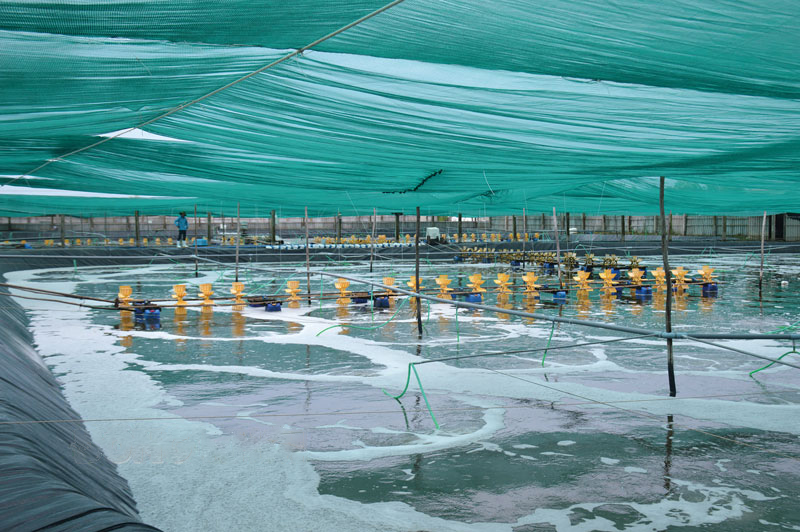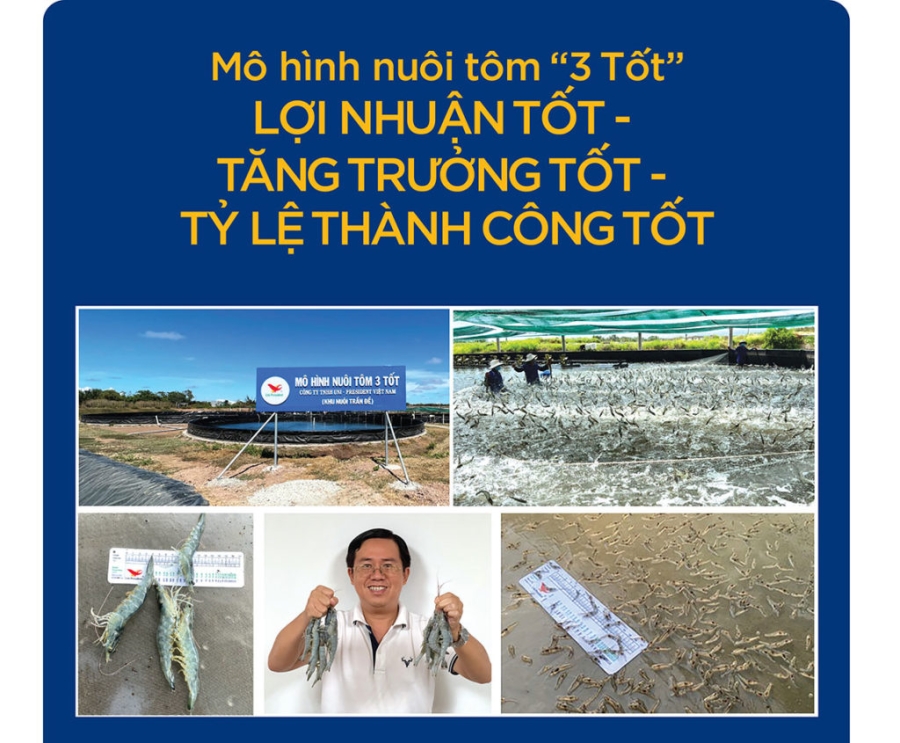Currently, high-tech shrimp farming has become a local trend to catch up with the trend. In many coastal provinces and cities, the farming area is increasing, thereby forming high-tech shrimp farming areas that attract investment from businesses.
Hi-tech shrimp farming
For many years, the brackish water shrimp farming areas in the coastal provinces of the Mekong Delta have had popular shrimp farming models such as extensive and semi-intensive farming. In which, there are many improved models to increase productivity and reduce disease risks that are widely applied by shrimp farmers. However, in recent years, there have been a number of enterprises investing in shrimp farming applying high technology - a completely new field, in order to control food quality and safety to international standards and improve food safety. efficiency and value of farmed shrimp.

Figure 1: High-tech shrimp farming model using aquaculture lines
Currently, in the two provinces of Soc Trang and Bac Lieu, there are more than 186,000 ha of brackish water shrimp farming areas. These are two localities with enterprises investing heavily in aquaculture, especially expanding the area of intensive shrimp farming with industrial scale, applying high technology. Following the new trend, applying technical advances to reduce the use of chemicals, antibiotics and micro-organisms, ensuring the standards of clean shrimp. In which, there is a significant model of shrimp farming lined with bottom tarpaulin, the success rate is over 90%, there have been a number of farms that have converted from earthen ponds to ponds lined with tarpaulins or ponds lined with tarpaulins.
In Ben Tre, on January 29, 2021, the Ben Tre Provincial Party Committee issued Resolution No. 04-NQ/TU on the development of Ben Tre towards the East in the 2021-2025 period with a vision to 2030, including public shrimp farming. high tech. The goal is that by 2025, Ben Tre province will develop 4,000 hectares of high-tech marine shrimp farming and 5,000 hectares by 2030. Of which, Binh Dai district occupies 2,000 ha, Thanh Phu district 1,500 ha and Ba Tri district 500 ha. According to the plan, by 2025, the output of brackish water shrimp farming applying high technology will reach 144,000 tons, the average growth rate will reach 41.42%. Ben Tre has been approved by the Ministry of Agriculture and Rural Development for an investment project to build infrastructure for aquaculture areas in Binh Dai district with a total investment of over VND 83 billion; The infrastructure project of 2,000 hectares of shrimp farming area with high-tech application in Ba Tri district was approved with a total investment of 160 billion VND, thereby, gradually completing the aquaculture area of the province.
With many potentials and advantages, Tan Phu Dong district, Tien Giang province is focusing on developing aquaculture in the direction of high technology, towards sustainable production. Currently, the district has more than 174 hectares of high-tech TTCT farming (2, 3 phases). The advantage of this model is that it shortens the farming time, is easy to manage environmental factors, feeds, diseases, etc., with an average yield ranging from 30 to 50 tons/ha. According to Vice Chairman of the District People's Committee Le Thanh Dang, over the past time, the area of industrial shrimp farming in the district has grown with nearly 2,000 hectares, with an output of nearly 20,000 tons. The area of industrial shrimp farming in the area increases by an average of more than 5% per year. Particularly, the extensive farming model improved the area of about 4,900 hectares, but the output was only about 2,500 tons. Compared with improved extensive shrimp farming, industrial shrimp farming is many times more efficient. It is known that in the coming time, Tan Phu Dong will develop concentrated shrimp production areas in places with suitable natural conditions, infrastructure systems and technical services are invested synchronously. The district will focus on solutions to gradually convert the traditional farming form to high-tech farming. The locality is calling for businesses to invest in high-tech aquaculture. When the models are implemented, people see that such production is effective, which will gradually change the farming mindset.
Towards sustainable value
Shrimp farming model “3 Good”: Good profit – Good growth – Good success rate; helped to limit water change, manage and control Vibrio, toxic algae, pH balance, alkalinity in shrimp ponds; low feed rate, especially without the use of antibiotics.

Figure 2: Model of shrimp farrming "3 Goods"
Shrimp farming “3 Goods” is a model that uses a small water treatment area, only 1/3 of the area under the currently recommended model. Therefore, the advantages of this model are: High efficiency of land use, saving of electricity costs, and reduction of water treatment chemical costs. The amount of water change is very small and is only equivalent to 1/5 of the total amount of water according to current models, suitable for areas with low water supply; thereby saving the cost of drugs, reducing the amount of minerals used, reducing labor costs. The model absolutely does not use antibiotics during the farming process, contributing to protecting the farming environment and improving competitiveness when exporting shrimp to export processing factories.
Currently, the "3 Goods" shrimp farming model has been applied by many customers in many localities throughout the country and has brought about positive effects. This is an area that also has great potential for developing high-tech shrimp farming, but the form of aquaculture in Phu Yen and Khanh Hoa provinces is mainly intensive or semi-intensive pond culture, but mainly on household scale and pond banks. small, not firmly invested, prone to landslides and breaks during storms or floods. Along with that, the farming area does not have a pond to store water, so it does not take the initiative to collect water for the pond. There is no wastewater treatment pond, so most of the wastewater from farming activities is discharged directly into the environment without treatment. according to the law. This leads to environmental pollution and frequent disease outbreaks in farming areas. Accordingly, the application of the "3 Goods" shrimp farming model is considered an open direction for the development of sustainable shrimp farming here.
With outstanding advantages, the "3 Goods" shrimp farming model has also been recognized and highly appreciated by shrimp farmers in Soc Trang province for its effectiveness in the implementation process. When the model does not change the pond structure, it is easy to implement, the process mainly uses microorganisms, does not use antibiotics, less water changes, low cost and high efficiency, the growth rate of shrimp is very good. Compared with the ponds stocked at the same time for 60 days, the “3 Good” model is 15-20 fish/kg. Currently, agents and customers in Soc Trang have been starting to deploy the "3 Goods" model across the region.
Customers wishing to use aquaculture lines can refer to the products below: